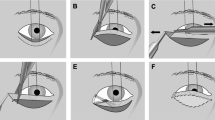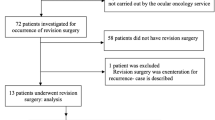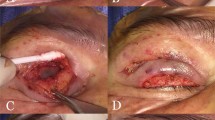Abstract
Purpose
To describe the clinical characteristics, surgical technique, and outcomes in patients with kissing nevi who underwent surgical management in two tertiary referral centers.
Methods
Medical chart review was conducted for all patients who underwent surgical repair in Moorfields Eye Hospital and The Children’s Hospital of Philadelphia. Demographics, medical history, lesion characteristics, surgical intervention, and outcomes were collected. Main outcome measures were surgical interventions as well as functional and cosmetic outcomes.
Results
Thirteen patients were included. Mean age at presentation was 23.46 years (±19.35,4–61), and the mean number of surgeries per patients was 1.9 (±1.3,1–5). Initial procedure included incisional biopsy in three cases (23%) and complete excision and reconstruction in 10 cases (77%). Surgery involved the upper and lower anterior lamella in all cases, the upper posterior lamella in 4 patients (31%), and the lower posterior lamella in 2 patients (15%). Local flaps were utilized in 3 cases and grafts in 5 cases. Complications included: trichiasis (n = 2, 15%), lower eyelid ectropion (n = 2, 15%), mild ptosis (n = 1, 8%), and upper/lower punctal ectropion (n = 1, 8%). Twelve patients (92%) were satisfied with the final functional and cosmetic outcome. No recurrence or malignant transformation were observed in any patient.
Conclusion
The surgical management of kissing nevi can be challenging, and commonly includes the use of local flaps or grafts, often requiring multiple interventions. The approach should be based on lesion size and location, proximity and involvement of key anatomical landmarks, as well as individual facial characteristics. Surgical management has a favorable functional and cosmetic outcome in the majority of patients.
This is a preview of subscription content, access via your institution
Access options
Subscribe to this journal
Receive 18 print issues and online access
$259.00 per year
only $14.39 per issue
Buy this article
- Purchase on Springer Link
- Instant access to full article PDF
Prices may be subject to local taxes which are calculated during checkout



Similar content being viewed by others
References
Margulis A, Adler N, Bauer BS. Congenital melanocytic nevi of the eyelids and periorbital region. Plast Reconstr Surg. 2009;124:1273–83. https://doi.org/10.1097/PRS.0b013e3181b5a58d
Fuchs A. Divided nevi of the skin of the eyelid. Klin Monbl Augenheilkd Augenarztl Fortbild. 1960;137:504–5.
Savas S, Balı YY, Erdemir AV, Simsek H. Divided nevus of the penis. Int J Dermatol. 2018;57:724–6. https://doi.org/10.1111/ijd.13899
Torchia D, Vega J, Miteva M, Romanelli P, Schachner LA. "Alternately divided" epidermal nevus of the fingers. Pediatr Dermatol. 2012;29:381–3. https://doi.org/10.1111/j.1525-1470.2011.01472.x
Desai SC, Walen S, Holds JB, Branham G. Divided nevus of the eyelid: review of embryology, pathology and treatment. Am J Otolaryngol. 2013;34:223–9. https://doi.org/10.1016/j.amjoto.2013.01.004
Hamming N. Anatomy and embryology of the eyelids: a review with special reference to the development of divided nevi. Pediatr Dermatol. 1983;1:51–58. https://doi.org/10.1111/j.1525-1470.1983.tb01092.x
Ehlers N. Divided nevus. Acta Ophthalmol. 1969;47:1004–11. https://doi.org/10.1111/j.1755-3768.1969.tb03724.x
Jia R, Zhu H, Lin M, Li Z, Sun Y, Luo M, et al. Clinicopathological characteristics and surgical outcomes of divided nevus of the eyelids: a decade’s experience on 73 cases. Ann Plast Surg. 2012;68:166–70. https://doi.org/10.1097/SAP.0b013e3182119155
Marghoob AA, Borrego JP, Halpern AC. Congenital melanocytic nevi: treatment modalities and management options. Semin Cutan Med Surg. 2007;26:231–40. https://doi.org/10.1016/j.sder.2008.03.007
Vora RV, Shah AJ, Patel TB. Congenital melanocytic kissing nevus on right eyelid - a rare phenomenon. Indian Dermatol Online J. 2020;11:627–8. https://doi.org/10.4103/idoj.IDOJ_481_19
Alfano C, Chiummariello S, De Gado F, Fioramonti P, Bistoni G, Scuderi N. Divided nevus of the eyelids: three case studies. In Vivo. 2007;21:137–9. http://www.ncbi.nlm.nih.gov/pubmed/17354627 Accessed 27 Sept 2021.
Papadopoulos O, Chrisostomidis C, Konofaos P, Georgiou P, Frangoulis M, Besti E, et al. Divided naevus of the eyelid, seven cases. J Plast Reconstr Aesthetic Surg 2007;60:260–5. https://doi.org/10.1016/j.bjps.2005.12.032
Cho H-J, Lee W, Jeon M-K, Park J-O, Yang E-J. Staged mosaic punching excision of a kissing nevus on the eyelid. Aesthetic Plast Surg. 2019;43:652–7. https://doi.org/10.1007/s00266-019-01362-0
Singh M, Gautam N, Kaur M, Zadeng Z. Role of amniotic membrane and full-thickness skin graft in reconstruction of kissing nevus of eyelids. Indian J Ophthalmol. 2017;65:1219–21. https://doi.org/10.4103/ijo.IJO_407_17
Zhu L, Qiao Q, Liu Z, Wang Y, Zeng A, Li W, et al. Treatment of divided eyelid nevus with island skin flap: report of ten cases and review of the literature. Ophthal Plast Reconstr Surg. 2009;25:476–80. https://doi.org/10.1097/IOP.0b013e3181b81eb7
McDonnell PJ, Mayou BJ. Congenital divided naevus of the eyelids. Br J Ophthalmol. 1988;72:198–201. https://doi.org/10.1136/bjo.72.3.198
Kaplan EN. The risk of malignancy in large congenital nevi. Plast Reconstr Surg. 1974;53:421–8. https://doi.org/10.1097/00006534-197404000-00007
Watt AJ, Kotsis SV, Chung KC. Risk of melanoma arising in large congenital melanocytic nevi: a systematic review. Plast Reconstr Surg. 2004;113:1968–74. https://doi.org/10.1097/01.prs.0000122209.10277.2a
Wu-Chen WY, Bernardino CR, Rubin PAD. The clinical evolution of a kissing naevus after incomplete excision. Br J Ophthalmol. 2004;88:848–9. https://doi.org/10.1136/bjo.2003.035634
Myles PS, Leslie K, Silbert B, Paech MJ, Peyton P. A review of the risks and benefits of nitrous oxide in current anaesthetic practice. Anaesth Intensive Care. 2004;32:165–72. https://doi.org/10.1177/0310057X0403200202
Acknowledgements
The data that support the findings of this study are available on request from the corresponding author and after approval of the local IRB. The data are not publicly available due to containing information that could compromise the privacy of research participants. Patient consent has been received for the publication of Figs. 1, 2, and 3.
Author information
Authors and Affiliations
Contributions
OZ: Conception or design of the work, Data collection, Data analysis and interpretation, Drafting the article, Critical revision of the article, Final approval of the version to be published. DL: Data collection, Data analysis and interpretation, Critical revision of the article, Final approval of the version to be published. JAK: Critical revision of the article, Final approval of the version to be published. WRK: Critical revision of the article, Final approval of the version to be published. GBS: Critical revision of the article, Final approval of the version to be published. DHV: Conception or design of the work, Data collection, Critical revision of the article.
Corresponding author
Ethics declarations
Competing interests
The authors declare no competing interests.
Additional information
Publisher’s note Springer Nature remains neutral with regard to jurisdictional claims in published maps and institutional affiliations.
Rights and permissions
About this article
Cite this article
Zloto, O., Landau Prat, D., Katowitz, J.A. et al. The surgical management and outcomes of kissing nevi of the eyelids. Eye 37, 3015–3019 (2023). https://doi.org/10.1038/s41433-023-02463-6
Received:
Revised:
Accepted:
Published:
Issue Date:
DOI: https://doi.org/10.1038/s41433-023-02463-6



